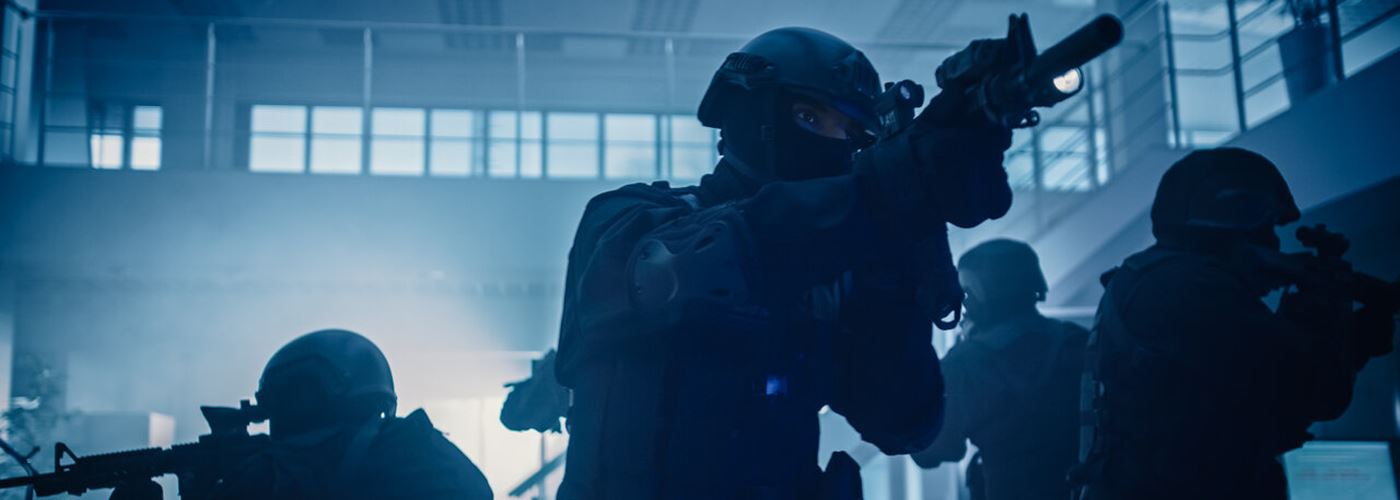
This series is comprised of 4 individual blogs addressing the central theme When Hollywood Gets It Wrong…. Hollywood is grossly inaccurate in their portrayal of armed confrontations. Understanding that Hollywood gets it wrong may save your life!
Ballistics
1. “Bullets stop when they make contact with…”
I have seen Hollywood action movies and crime dramas portray gunfights where virtually every object, including pillows, mattresses, tables, sofas, windows, doors, interior walls, car doors, windshields, and even human beings are depicted as bulletproof barriers that can stop bullets. In the exaggerated world of Hollywood, it seems that everything stops bullets.
A particular action-packed movie that I have enjoyed, showed our hero and his “date” being pursued by a professional sharpshooter who was driving a vehicle and relentlessly shooting at our protagonists in their vehicle. At one thrilling point, our hero maneuvers his vehicle, a stolen police cruiser, into a spin and daringly steps out of his car while it is still spinning, leaving his date in the moving car. Our hero then starts shooting, with impeccable aim and rapid fire, into the windshield and window of the shooter’s car. Positioned behind the steering wheel, a universal driver's position, the shooter appears invulnerable. After emptying one magazine, our relentless hero reloads and discharges another magazine into the assailant’s vehicle. Despite the windshield being shredded to pieces, the shooter astonishingly manages to back up and escape, emerging unscathed.
Problems: The concept of our hero stepping out of a spinning vehicle raises multiple logistical issues, including the improbable avoidance of being overrun by the spinning vehicle itself. The attention-grabbing special effects might be visually captivating, but they lean heavily into the realm of cinematic fantasy rather than practical reality.
In the real world of forensic science and ballistics analysis, bullets tend to penetrate most objects they come into contact with. Through my experience in law enforcement and crime scene investigation, I recall incidents where a bullet has tragically passed through the body of one victim and struck another person standing behind. Variables such as bullet caliber, firing distance, clothing, body type, and targeted body parts all influence whether a bullet may pass through a person and continue its deadly trajectory. In a chilling case, I observed a bullet that traveled through a person’s head, perforated a residential wall, crossed a room, and lodged into another wall. Contrary to Hollywood's portrayal, human bodies offer minimal ballistic protection.
One of the most pervasive myths in Hollywood's action and thriller genres is the notion that bullets ricochet off of windshields, that car doors and windows provide bullet-stopping defense, and that the rear of a vehicle is impenetrable to gunfire aimed at the driver. This fallacy is so regularly exhibited in movies and TV shows that audiences might be misled to believe it reflects reality. However, my professional testing with various vehicle models under different simulated gunfire scenarios, as well as my involvement in vehicular homicide cases, revealed alarming findings.
Cars, to the disappointment of Hollywood's narrative, serve as very poor shields against gunshots, regardless of the angle of attack—frontal, lateral, or rear. Through direct ballistics testing, I found that bullets effortlessly penetrated car windshields, windows, and doors, maintaining lethal speed and trajectory. Car doors failed to offer any substantial resistance to bullets unless by sheer chance they hit a steel support structure within the door. In a systematic test firing at a car door, a significant majority of approximately 80+% of rounds, including commonly available "street" rounds like .38 specials, 9mm, .40 caliber pistols, and various rifle ammunition, including standard military and high-powered rounds, penetrated through to the passenger cabin.
Note: When someone is driving a vehicle, their predictable position behind the steering wheel is well-known to all, including potential attackers. If conventional wisdom and cinematic portrayals suggest that windshields and doors can shield drivers from bullets, the frequent survival of drivers in high-stakes cinematic shootouts begs disbelief. It is a flight of fancy to depict multiple, skilled gunmen unleashing a barrage of gunfire into the driver's side of a vehicle without inflicting harm on the driver.
With regards to construction materials such as doors and interior walls, their inability to stop bullets is notable. Efforts by the construction industry to minimize costs have inadvertently compromised the structural integrity and, consequently, the protective capacity of these elements against ballistics. My observations from investigating shootings have consistently shown that bullets typically penetrate doors and walls with ease. While there are exceptions, such as concrete walls and steel-reinforced doors, these are rare and not the standard in most residential and commercial buildings.
2. "He's Got a Bulletproof Vest… He is Unstoppable!"
We have observed numerous movies where the protagonist, often portrayed as an invincible action hero, is wearing a bulletproof vest, and despite being shot repeatedly, the wearer miraculously survives and appears unstoppable. Despite facing gunfire from various types of firearms, our hero perseveres!
Problems: Soft body armor is not invulnerable, and certain types of bullets, particularly high-caliber ammunition, can penetrate most vests. Unless fitted with ceramic or steel ballistic plates for enhanced protection, most rifle bullets—including military-grade ammunition and high-powered projectiles—will penetrate the standard soft body armor. Even if a bullet is stopped by the vest, the force can cause blunt force trauma, leading to potential serious injuries such as fractured bones and internal damage.
Even with theoretically indestructible body armor, tactical experts and law enforcement professionals understand that if targeting the body is ineffective, then aiming for an unprotected area like the head is the next tactical choice. This method, known as the "two in the body, one in the head" principle, is a drill practiced by many police tactical teams and highlights that bulletproof vests alone do not render an individual invulnerable.
3. "Someone Racks a Bullet in the Chamber!"
A pivotal scene unfolds as either a protagonist or antagonist gears up for an imminent gunfight. In a dramatic moment, the character ostensibly readies their weapon by racking a round into the chamber of the pistol they wield.
Problems: This moment, designed to escalate tension, overlooks a critical detail familiar to firearms enthusiasts and professionals alike regarding the operation of semiautomatic pistols. The necessity to chamber a round at such a crucial juncture implies that the individual has been moving with a firearm that was previously not ready to fire—a scenario unlikely for experienced gun handlers like law enforcement officers, secret agents, or even seasoned criminals, who typically would carry their firearms with a round chambered and ready for immediate action.
